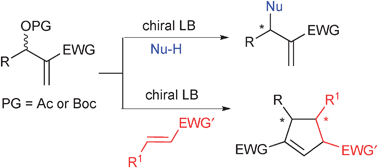Organocatalytic asymmetric transformations of modified Morita–Baylis–Hillman adducts
Abstract
Chiral Lewis basic

* Corresponding authors
a Department of Medicinal Chemistry, College of Pharmacy, The Third Military Medical University, Chongqing 400038, China
b
Key Laboratory of Drug-Targeting and Drug Delivery System of the Education Ministry, Department of Medicinal Chemistry, West China School of Pharmacy, Sichuan University, Chengdu 610041, China
E-mail:
ycchenhuaxi@yahoo.com.cn
Fax: +86 28 85502609
Tel: +86 28 85502609
c The J. David Gladstone Institutes, 1650 Owens Street, San Francisco, USA
Chiral Lewis basic

 Please wait while we load your content...
Something went wrong. Try again?
Please wait while we load your content...
Something went wrong. Try again?
T. Liu, M. Xie and Y. Chen, Chem. Soc. Rev., 2012, 41, 4101 DOI: 10.1039/C2CS35017C
To request permission to reproduce material from this article, please go to the Copyright Clearance Center request page.
If you are an author contributing to an RSC publication, you do not need to request permission provided correct acknowledgement is given.
If you are the author of this article, you do not need to request permission to reproduce figures and diagrams provided correct acknowledgement is given. If you want to reproduce the whole article in a third-party publication (excluding your thesis/dissertation for which permission is not required) please go to the Copyright Clearance Center request page.
Read more about how to correctly acknowledge RSC content.
 Fetching data from CrossRef.
Fetching data from CrossRef.
This may take some time to load.
Loading related content
